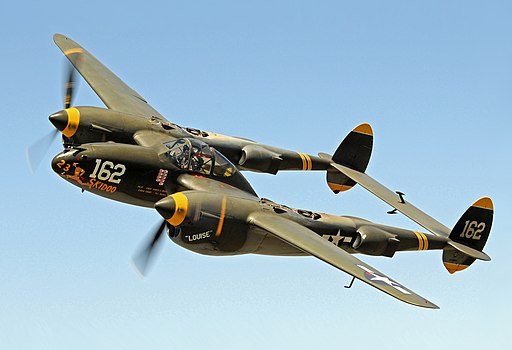The chronicles of World War II aviation brim with stories of brave pilots, breathtaking aerial maneuvers, and iconic aircraft. Among the roster of formidable flying machines that dominated the skies of Europe and the Pacific, Lockheed’s P-38 Lightning stood out among the crowd. Christened the ‘Fork-Tailed Devil’ by a begrudging German Luftwaffe, the P-38’s silhouette remains one of the most distinct and evocative of the era.
A Visionary’s Brainchild
The P-38’s journey from conception to combat is a masterclass in innovation. Spearheaded by the genius of Clarence “Kelly” Johnson, one of Lockheed’s most gifted engineers, the plane’s design defied traditional conventions. Instead of a single fuselage, it sported twin booms and a central nacelle for the pilot—a feature that lent it an unusual but menacing appearance. Such an audacious design was not mere folly but a calculated solution to accommodate the aircraft’s advanced turbo-superchargers, promising enhanced altitude performance.
Unparalleled Speed and Power
The P-38’s twin Allison V-1710 engines, coupled with its unique design, allowed it to eclipse other fighters in speed and altitude. While other aircraft jockeyed for superiority in the skies, the Lightning effortlessly cruised at altitudes exceeding 40,000 feet. This high-altitude supremacy allowed pilots to spot enemy formations from afar, dive with predatory grace, and strike with a ferocity that left foes reeling.
An Arsenal in the Sky
Beyond its speed and altitude prowess, the P-38 came armed to the teeth. Its centralized armament of machine guns and cannon, all clustered in the nose, reduced the dispersion of bullets and shells. This meant that when a P-38 pilot aimed, his weapons converged on the target with lethal precision. One can only imagine the dread an enemy pilot felt as the Lightning bore down on them, its weapons spitting fiery retribution.
A Guardian Angel Over Europe
The German Luftwaffe was no stranger to formidable foes. Yet, what made the P-38 particularly vexing was its versatility. Not just a fighter, the P-38 proved adept at reconnaissance, bomber escort missions, and ground attacks. This adaptability ensured that the ‘Fork-Tailed Devil’ was a constant thorn in the side of German military strategists. Moreover, its long range made it a frequent escort for bombers, safeguarding them as they delivered payloads deep into enemy territory.
A Symbol of Aerial Supremacy
The fear and respect the P-38 commanded from its adversaries weren’t just a product of its technical prowess. Pilots like Major Richard Bong, the United States’ highest-scoring ace of World War II, became legends in their Lightnings. Their tales of valor, underpinned by the aircraft’s capabilities, added to the mythos of the P-38.
In Retrospect
Decades have passed since the last P-38 soared through combat skies, yet its legacy endures. The ‘Fork-Tailed Devil’ is a testament to the marriage of innovative design and unyielding spirit. If you’ve ever seen it in action, whether you were gripping its controls or just craning your neck from below, the P-38 isn’t merely a piece of machinery. It’s a living memory of days when battles up in the skies could shift the future of whole nations.
Are you getting up close and personal with the P-38? Well, you’re getting a firsthand feel for the heart and soul of World War II air battles: a wild cocktail of the latest gadgets, clever game plans, and pure, undiluted bravery. As we reflect on those tumultuous years, the image of the Lightning, diving from the heavens with its twin tails trailing behind, serves as a poignant reminder of the sacrifices made and the heroes born in the crucible of war.
For more insights into the P-38 and other important military aircraft, visit Aces In Action. Here, you’ll find an amazing piece of artwork by Craig Tinder titled “Operation Vengeance,” which illustrates the P-38 Lightnings of the 339th Fighter Squadron. The limited edition canvas print includes a piece of an original 1940s P-38 oil tank and other components recovered in 2020 from an aircraft hangar in Los Angeles, California.
Operation Vengeance – P-38 Lightning Aviation Art by Craig Tinder
18 April 1943 – After crossing over 400 miles of open and obscured by the morning mist, P-38G Lightnings of the 339th Fighter Squadron reached a predetermined intercept point over Bougainville Island to ambush a fight of Japanese Betty Bombers. Lt. Rex Barber, flying P-38G “Miss Virginia”, closed in on the Betty Bombers transporting Admiral Isoroku Yamamoto – the mastermind behind the attack on Pearl Harbor. Both Betty Bombers were shot down and left Japan reeling at the loss of their most talented admiral.






Share:
Major Richard “Pete” Peterson: The Triple Ace of Leiston and his Beloved P-51 Mustangs
From Cockpit to Courtroom: The Transition of Charles Older